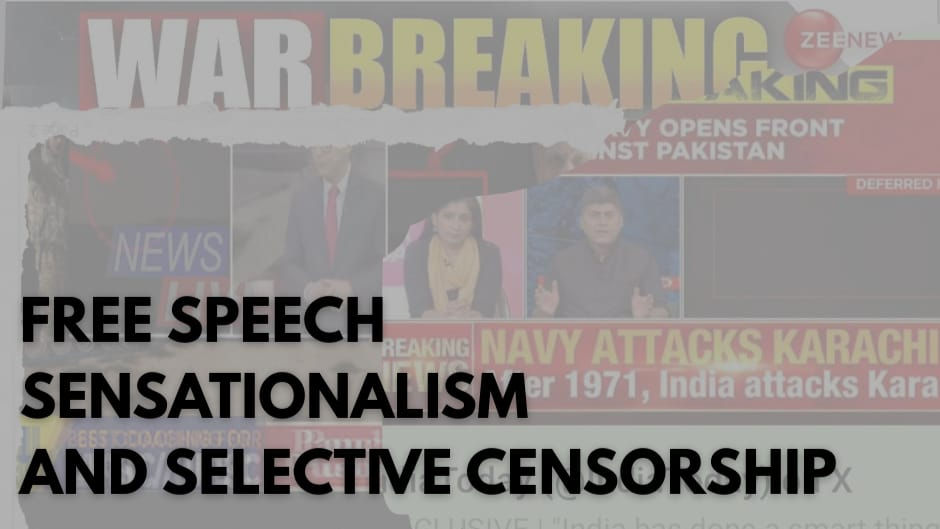FREE SPEECH, SENSATIONALISM, AND SELECTIVE CENSORSHIP
- Rizmi Lia
- May 10
- 4 min read
In the wake of tragedy and escalating tensions between India and Pakistan, a disturbing reality has emerged: sensationalism flourishes, false information spreads freely, and voices advocating for peace are slutshamed.

The past few weeks have laid bare the real cost of conflict and disengagement on free speech, press freedom, and public discourse. Since the tragic Pahalgam attack, in which 26 civilians lost their lives, social media erupted in grief, outrage, and a wave of performative nationalism. The pain of the nation was captured in a haunting image of a woman sitting motionless beside her husband's body. That photograph flooded timelines and became a symbol of collective mourning.
The woman in the picture was Himanshi Narwal. Her husband, Vinay Narwal, a 26-year-old naval officer, had been killed during what should have been their honeymoon. They had been married for less than a week.
What followed showed us the duality of media in India, one that fiercely claims to protect free speech and another that willingly participates in its erosion. The same day, the BJP Chhattisgarh handle posted a Ghibli-style animated version of the attack, captioned in Hindi: “Faith was asked, not caste… we will remember.”
This was freedom of expression?
In the days that followed, Kashmiri students and civilians were reportedly targeted by extremist Hindu groups, as documented by the BBC. When Himanshi Narwal appealed for peace and unity, she was no longer seen as a grieving widow. She became a target. Her message, “We don’t want this. We want peace and only peace” sparked a swift and vicious backlash online. Those who had mourned her husband’s death now hurled abuse at her. Survivors who dared to show compassion towards Kashmiris were slut-shamed, vilified, and accused of betrayal.
This was free speech?
At the same time, as India and Pakistan faced military escalation, mainstream Indian news channels plunged headfirst into a wave of sensationalist, unverified, and jingoistic reporting. Their coverage often bordered on fiction, sometimes without attribution, often citing "sources," and always delivered with high-decibel certainty. Here are five of the most prominent false stories:
Arrest of Pakistan Army Chief Asim Munir Zee News, ABP News, Thanthi TV, and Zee Telugu claimed Pakistan’s Army Chief had been arrested. They named a potential replacement and spoke of internal dissent. No official source confirmed this. The story was entirely fabricated.
Destruction of Karachi Port Channels like ABP Ananda and Republic Bangla reported that the Indian Navy had bombed Karachi Port. One channel even aired an old plane crash video as supposed footage of the attack. There was no verification, no evidence, just war fantasy disguised as breaking news.
Fake Fidayeen Attack in Rajouri Aaj Tak anchors reported a suicide attack in Rajouri. The Indian Army later called it "completely false." The segment had no source, no facts, just hysteria.
12 Pakistani Cities ‘Destroyed’, PM in Hiding Some Assamese channels, along with Zee News and Times Now Nava Bharat, claimed Pakistan's cities had been destroyed and Prime Minister Shehbaz Sharif was hiding in a bunker. These were outright lies, broadcast like truth.
Pakistani Fighter Jets Downed, Pilot Captured A deepfake video claimed India had shot down Pakistani jets and captured a pilot. Reputable outlets, including India Today and Republic, picked it up. Pakistani officials later confirmed it was fake. No Indian authority backed the claim.
Amid this chaos, only a few independent media houses stuck to facts. Some among them, platforms like The Wire, Maktoob Media, and The Kashmiriyat reported responsibly and they paid the price. Around 8,000 X accounts were blocked in India, following government directives. The Global Government Affairs team at X (formerly Twitter) revealed that no clear explanation was given in many cases. Accounts of international news outlets and public figures were restricted. X complied in India only but stated it did not agree with the government’s demands.
The government had issued a blocking order of The Wire over one article, the news portal said, but technical constraints do not allow granular censorship without a website’s cooperation. The portal was not given a chance to address the issue before being taken down.
In contrast, mainstream media houses that indulged in warmongering, fearmongering, and misinformation were untouched. Their incitement wasn't considered hate or violence. They weren’t asked for corrections. They weren’t blocked.
This was free speech?
Now, these independent media outlets continue their reporting through alternate accounts, cautious, quiet, and always looking over their shoulder. The contrast couldn’t be clearer. Survivors turned into targets. Peace advocates vilified. News made into cartoons. And facts buried under noise.
The very people who once held Himanshi Narwal up as the face of national grief were quick to slut-shame her for speaking about peace. The legacy media, which proudly spread fake stories and warmongering, faced no consequences. The same people glorifying “Operation Sindoor” had no problem turning on a widow whose only ‘crime’ was a plea for humanity.
If these last few days haven’t revealed the true nature of our mainstream media, of our Twitter warriors, and of the daylight feminists who go silent when it's inconvenient, then what will? The government’s selective censorship cloaked as national security has become impossible to ignore.
I remember a tweet that cut through the noise: “Most of the mainstream media isn’t doing journalism. Those who did it right are in jail.”
And that, perhaps, says it all.





Comments